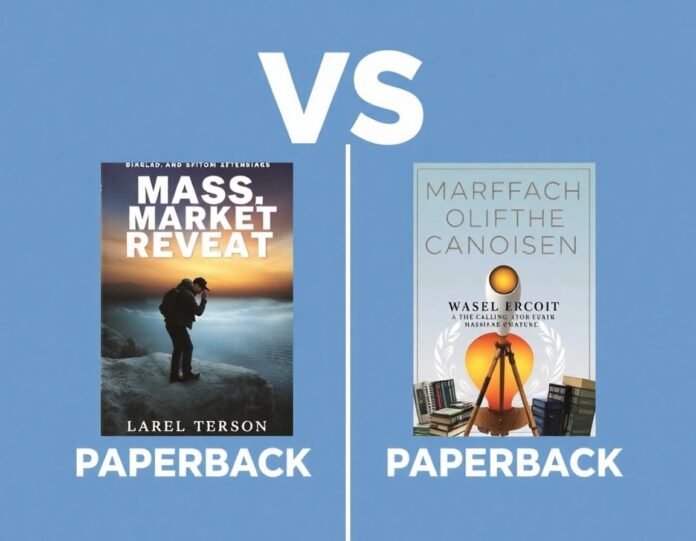When browsing the book aisle or online bookstores, you might notice that books are available in various formats. Two common options that often confuse readers are mass market paperback vs paperback. While both are paperback editions, they differ significantly in size, purpose, and overall design.
If you’ve ever wondered about the distinctions between these formats and which one to choose, this article will provide a detailed comparison of mass market paperback vs. paperback to help you make an informed decision.
What Is a Mass Market Paperback?
A mass market paperback is a smaller, more compact version of a book designed for wide distribution at an affordable price. These editions are commonly sold in places like airports, grocery stores, and drugstores, in addition to traditional bookstores.
Characteristics of Mass Market Paperback
Size: Typically smaller, around 4.25 x 7 inches, making it easy to hold and carry.
Binding: Often uses glue binding, which makes the book less durable but cost-effective.
Paper Quality: Printed on lower-quality, thinner paper to reduce production costs.
Price: Generally more affordable than standard paperbacks or hardcovers.
Target Audience: Aimed at casual readers who prioritize convenience and affordability.
Mass market paperbacks are popular for genre fiction, such as romance, thrillers, and science fiction, and are often reprints of previously released books.

What Is a Paperback?
A standard paperback, also known as a trade paperback, is larger and more durable than a mass market edition. These editions are commonly found in bookstores and libraries and are designed for readers who value quality alongside affordability.
Characteristics of Paperback (Trade Paperback)
Size: Typically larger, around 5.5 x 8.5 inches or 6 x 9 inches.
Binding: often uses higher-quality glue or sewn binding for better durability.
Paper Quality: Printed on better-quality paper, offering a more premium reading experience.
Price: More expensive than mass market paperbacks but cheaper than hardcovers.
Target Audience: Appeals to readers who prefer a comfortable reading experience and aesthetic appeal.
Trade paperbacks are common for literary fiction, nonfiction, and newly released books that are not in hardcover format.
Advantages of Mass Market Paperback
Affordability: These editions are budget-friendly, making them accessible to a broader audience.
Portability: Their compact size makes them ideal for on-the-go reading.
Wide Availability: Found in non-traditional book-selling venues like supermarkets and convenience stores.
Perfect for Genre Fiction: Popular for books that readers consume quickly, such as romance novels and mysteries.
Disadvantages of Mass Market Paperback
Durability Issues: The thinner paper and glue binding can lead to wear and tear with repeated use.
Reduced Aesthetic Appeal: Smaller size and lower paper quality may not be as visually pleasing on bookshelves.
Comfort: Smaller fonts and compact layouts can make reading less comfortable for extended periods.
Advantages of Paperback (Trade Paperback)
Enhanced Reading Experience: Larger size and better paper quality make them more enjoyable to read.
Durability: Sturdier construction ensures a longer lifespan.
Aesthetic Appeal: Trade paperbacks are often more visually appealing and make a great addition to any bookshelf.
Versatility: Suitable for a variety of genres, from literary fiction to academic texts.
Disadvantages of Paperback (Trade Paperback)
Higher Cost: Trade paperbacks are more expensive than mass market editions, which might deter budget-conscious readers.
Less Portable: A larger size may be less convenient for readers who travel frequently.
Which Format Should You Choose?
Your choice between mass market paperback and paperback depends on your preferences, reading habits, and budget.
Choose Mass Market Paperback If:
You prioritize affordability.
You’re looking for a compact book to carry while traveling.
You’re reading a genre like romance or mystery, where quality may be less important.
Choose Paperback (Trade Paperback) If:
You value a premium reading experience with better print quality.
You want a book that will last longer.
You enjoy collecting aesthetically pleasing editions.
Mass Market Paperback vs. Paperback in the Publishing World
From a publisher’s perspective, both formats serve different purposes:
Mass Market Paperbacks: focused on high-volume sales, often targeting casual readers and non-traditional retail outlets. These editions allow publishers to make books widely available at a lower cost.
Trade Paperbacks: cater to readers who are willing to pay more for quality. They are often used for newer titles or special editions.
Authors and publishers often release books in multiple formats to maximize reach and revenue. For instance, a book might first be published as a hardcover, followed by a trade paperback edition, and eventually a mass market paperback.
How Retailers Position Mass Market Paperbacks and Paperbacks
Retailers strategically position these formats to cater to different customer needs:
Mass Market Paperbacks: Found in high-traffic areas like checkout counters or airport kiosks, where impulse buying is common.
Trade Paperbacks: displayed in dedicated book sections with more thoughtful organization, appealing to avid readers.
The Environmental Impact
Sustainability is becoming a significant concern in the publishing industry. While mass-market paperbacks are more affordable, their lower-quality materials and shorter lifespan may contribute to waste. Trade paperbacks, with their higher-quality construction, might be a more sustainable choice for readers looking to minimize their environmental footprint.
Future Trends: The Evolution of Book Formats
As digital books and audiobooks continue to gain popularity, the demand for physical books remains strong. However, trends indicate that readers are gravitating toward formats that offer unique experiences:
Collector’s Editions: Special trade paperbacks with exclusive content or premium designs.
Hybrid Formats: Books that combine digital features with physical components, like QR codes for accessing multimedia content.
Eco-Friendly Editions: Publishers are exploring sustainable materials for both mass market and trade paperbacks.
Conclusion
The debate between mass market paperback vs. paperback boils down to your reading priorities. If affordability and portability are key, the mass market paperback is an excellent choice. On the other hand, if you value durability, aesthetic appeal, and a better reading experience, trade paperbacks are worth the investment.
By understanding the differences and weighing the pros and cons, you can choose the format that best fits your needs and preferences. Whether you’re building a personal library or looking for your next travel companion, there’s a paperback edition out there for you.
You may also read: Tribal Loans No Credit Check – Quick Approval


